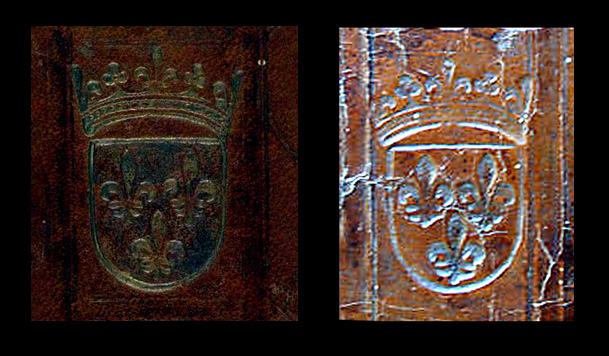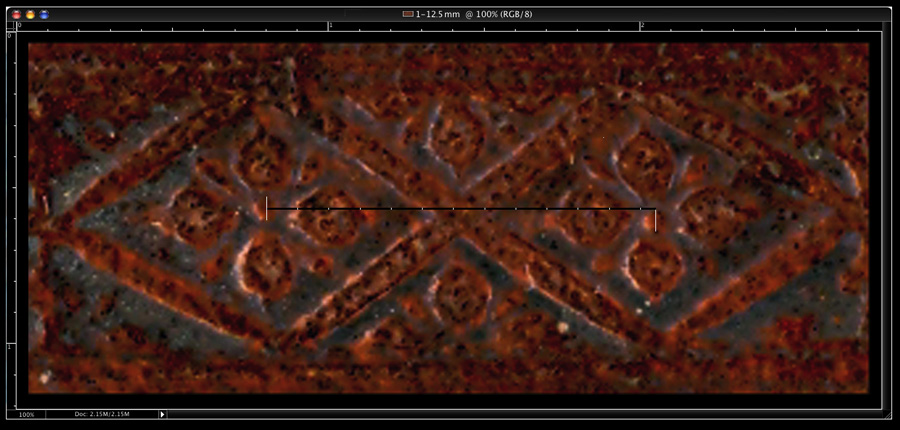This is when you nearly jump to the roof! Reading the "notes" for c29b26 we find "Macchi states; first quarter century, Paris, bound by the Atelier Louis XII workshop, the first in France to provide bindings with gold (tooling), probably located in Paris who bound for Louis XII. About 45 known examples"! (my exclamation mark)
Of course nothing is certain when it comes to buying books on the internet and a certain amount of caution was exercised by everyone bidding on this item. In fact I don't think there was that many... who would believe that you could buy, on eBay, for 47 euros, a royal bookbinding that is nearly 500 years old? Not to mention that there are maybe only 5 in the world that have the royal arms accompanied by this azure blue salamander.... but I am getting ahead of myself. Once you manage to win such an item you start in earnest researching bindings from this period and particularly the atelier of Louis XII. The British Library notes give us a good starting point and we soon discover that the work of Jacques Guignard (ancien Conservateur en chef de la Bibliothèque de l'Arsenal)
is probably the most thorough publication available as concerns the Louis XII bindings. Here, I have to thank the editor of She-philosopher.com Deborah Taylor-Pearce for scrambling about to send me a pdf copy of this publication.
Guignard, Jacques. "L'atelier des reliures Louis XII (Blois
ou Paris?) et l'atelier de Simon Vostre." In Studia
Bibliographica in Honorem Herman de la Fontaine Verwey Ed.
by S. van der Woude. Amsterdam: Menno Hertzberger, 1966
[1968]. 202-239.
As soon as I started researching this subject I began to see that everything that I had done up till this point was a sort of preparation for this new work, which was, even though, a direction that I had not imagined, that is to be suddenly working on the very beginnings of the history of French decorative gold tooled bookbindings. We are now going to explore this subject together, In his 1968 publication Jacques Guignard presents us with a list of 33 bindings which were at that time the sum total of specimens that could be shown to have derived from the workshops connected to Louis XII and Francois Ier. In the 1960s, and earlier, the normal approach to studying old bindings involved making rubbings of the decorative imprints from actual specimens. Obviously not too many people even had access to these rare items, otherwise one counted heavily on printed reproductions to make a comparative analysis. Today we can make use of technologies that make all previous work seem rather primitive by comparison. My first priority will be to reproduce on this site, high resolution copies of all the known specimens. However I should first outline some of the procedures involved in the replication of these bindings. The first tool needed is a simple flat bed scanner, sometimes the cheaper models are even better for this work. A scanner will give an image that is a thousand times more useful than a photograph, for the simple reason that a scanner gives you an exact highly accurate digital image that can be measured and manipulated in an endless variety of ways. Most importantly however, is the fact that a digital image can be rescaled very precisely. if you have a photograph of a binding, and you know the dimensions of the binding, you can precisely rescale the scanned photograph to the actual size and then make precise measurements from that. As we have found from our previous comparative study of gold tooled imprints, being able to measure accurately the imprint is vital. To be able to show two imprints side by side at exactly the same scale, allows a sure way to identify common imprints. I have taken the study of scanned imprints a step further, where a single high resolution imprint scan can be used to digitally rescale all the variously reproduced binding examples which share this common imprint. On the next page we will look at how this is done, and then move on to the Louis XII binding collection inventory.
|





